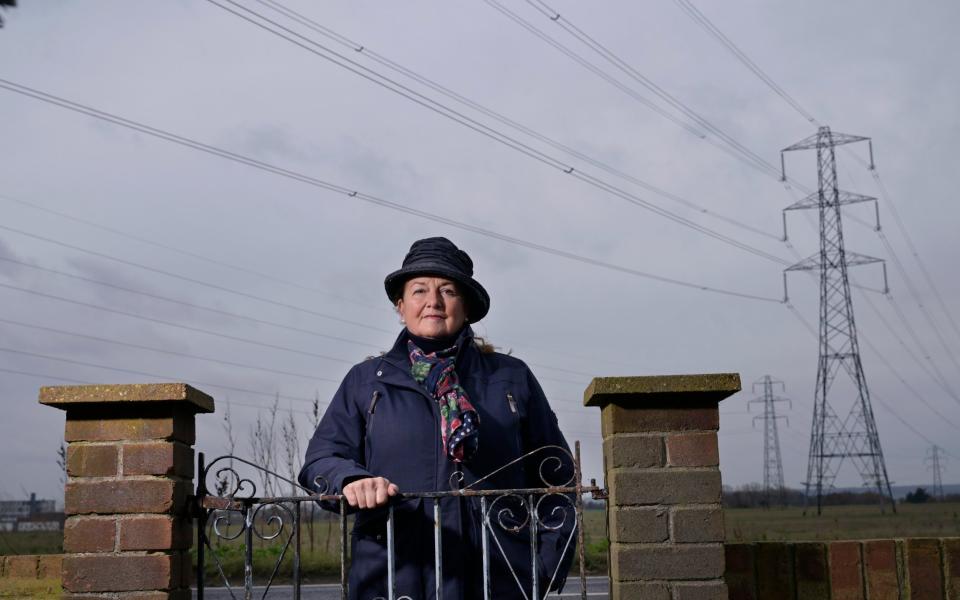‘I lived under a pylon and it was hell – now I’m battling to stop it happening again’

A row of pylons was forced upon my family’s farm in West Tilbury, Essex, in the 1950s, before I was born. They brought the power out of Tilbury towards Chelmsford, crossing the paddock that was right next to our farmhouse – our ponies grazed beneath the power lines.
As a child, I was continually aware of the buzzing and humming sounds they made, particularly when it was damp or foggy. You could feel the static electricity in the air and the barbed wire around the paddock had a current running through it as the electricity earthed.
My parents received some financial compensation but it didn’t make up for the ugliness or the disturbance or the dead birds we’d find lying beneath the cables. I can’t imagine it was a healthy place to live. My father died young and my mother suffered from horrific migraines. Any study that suggests links between high voltage cables and illnesses such as leukaemia seems to be debunked yet I wouldn’t want to bring up children anywhere near them. Friends avoided visiting us – they said they always got a headache – and whenever new people arrived they’d immediately ask, “What’s that noise?”
In my early 20s, I married and moved 25 miles away to Writtle, a beautiful part of Essex with deer parks and ancient forests, but now the National Grid is catching up with me again. The proposed 112-mile Norwich to Tilbury section of the Great Grid Upgrade, which will reinforce the high voltage power network between substations in Norwich, Bramford and Tilbury, passes right next to our house. On certain parts of the route, the cables will be buried because they cross areas of outstanding natural beauty, but around us they’re proposing super pylons – soaring metal giants that are taller than 11 double decker buses.
The pylons I grew up with are nothing compared with these monsters. Constructing each one will require a wide, concrete road to provide access for machinery, destroying acres of woodland and agricultural land, and the end result will scar the whole landscape and ruin businesses, tourism and communities.

This time we won’t be getting any compensation, as the pylons aren’t directly on our land, yet our lives will be sorely affected. Even though Norwich to Tilbury is only a proposal, it’s putting people off buying in the area. I dread to think how much value it’s knocked off our house and whether we’ll ever be able to sell in the future.
I’m all for upgrading the power network; it’s essential that we keep modernising our infrastructure. The proposed Norwich to Tilbury project will also connect new offshore wind generation, which can only be a good thing. It’s so windy here in East Anglia; I can see that it makes sense to harness the power. What I don’t understand is why, when they’re introducing new sustainable technology, they’re continuing to destroy the landscape with pylons and cables – what about taking the whole route offshore? In farming, you’re always trying to find a better, more environmentally friendly way; it’s simply not green policy to dig up landscape and bury cables, and build super pylons, higher than Nelson’s column, across our country.
Locally, we’re all panicking that the project will be bulldozed through at government level. It would be a catastrophe as there doesn’t seem to have been any joined-up thinking in terms of the route. In trying to avoid large conurbations and highly populated areas, they’ve gone straight through the countryside – including the historic Dedham Vale in the heart of Constable Country. Until recently, the route went over a school (it’s now been moved just to the side of it) and part of it includes land that has been compulsorily purchased for the Lower Thames Crossing road project, which couldn’t co-exist with power lines.
We’ve had two consultations and are now waiting for the final one in early 2024. So far, no one at National Grid seems to be able to prove that the proposed route is the best and most cost-effective way forward. The glossy brochures they send out, with people skipping through fields, don’t answer any of our questions. Given that the National Grid is cabling offshore in other places, it would be useful to know why it is not viable here.

A report in 2020 by National Grid ESO, a National Grid subsidiary that operates the electricity transmission system, suggested that offshore transmission networks are much cheaper. We’re not sure what point there is in another consultation: everyone has told National Grid twice that the offshore option is what is needed. That “everyone” includes 27,400 people on the Essex Suffolk Norfolk Pylons petition, all the region’s 14 MPs, and all three county councils, plus the district councils.
I’d never choose to buy a house near a pylon – for the aesthetics but also the noise and the static. But if the plans go ahead, I’m going to be living less than 100 metres away from the biggest type you can get. It’s frustrating when you have to fight so hard to get planning permission for a small extension in the green belt and yet the Government can give the green light to something so destructive, even when so many are opposed to it.
I think Jeremy Hunt’s announcement of a rebate on people’s energy bills is bribery to accept old technology: metal monstrosities that will destroy our natural environment.
There is a cheaper offshore option that should be considered as part of an integrated grid. This would be £2 billion cheaper with 50 per cent less infrastructure. That’s better for communities and the environment.
As told to Anna Tyzack

 Yahoo News
Yahoo News 
